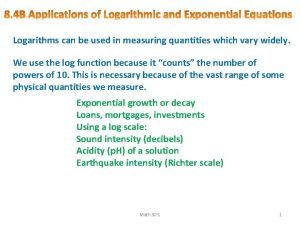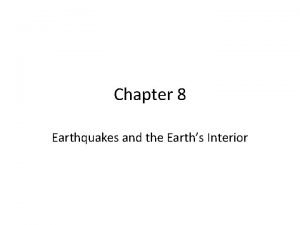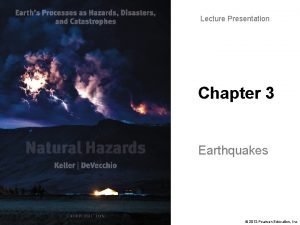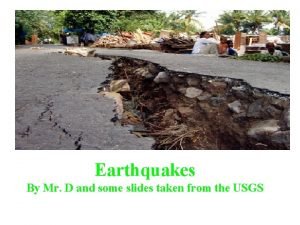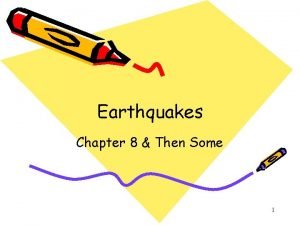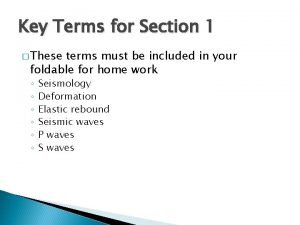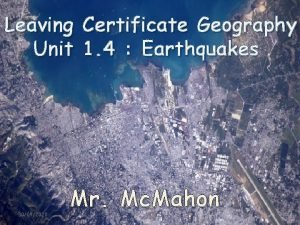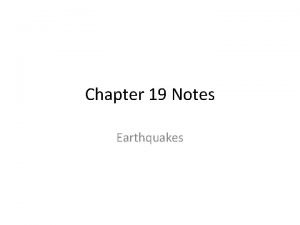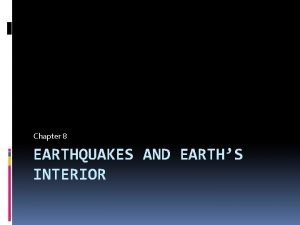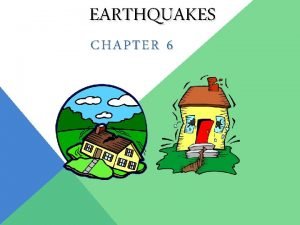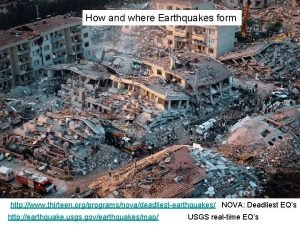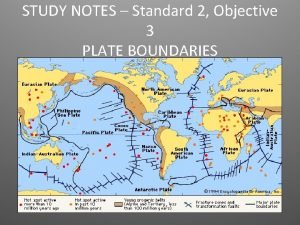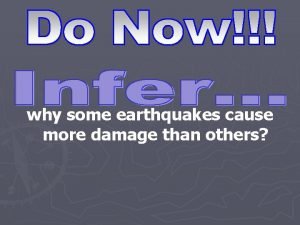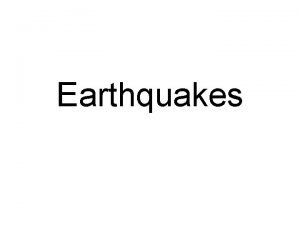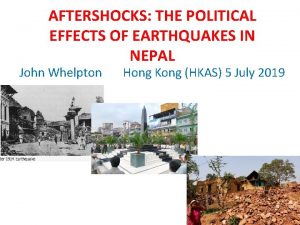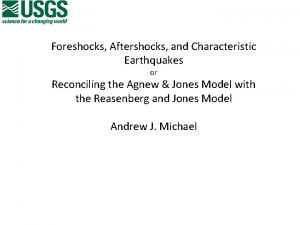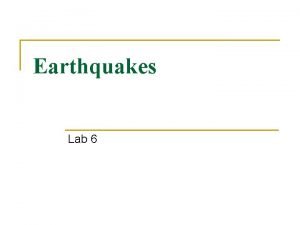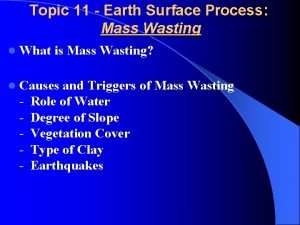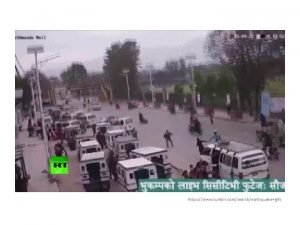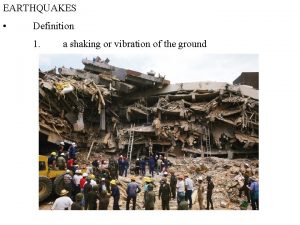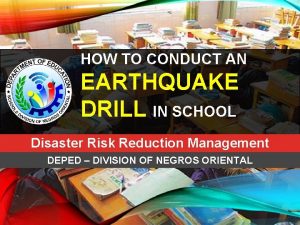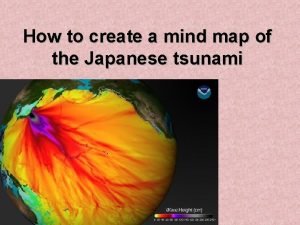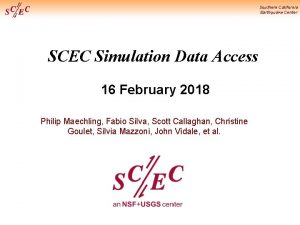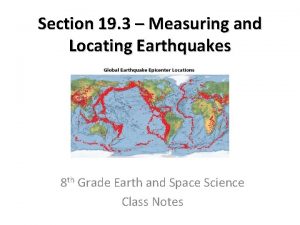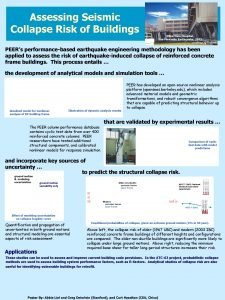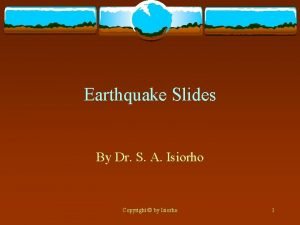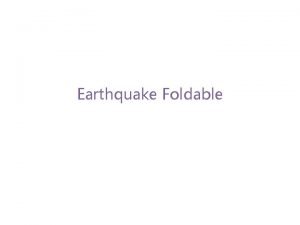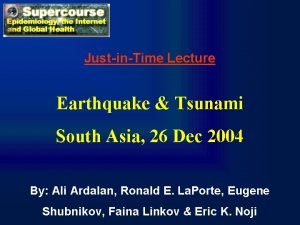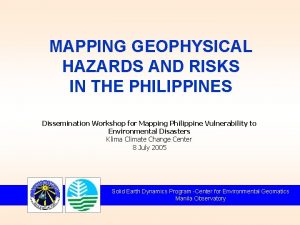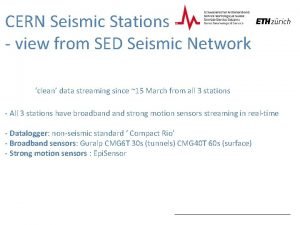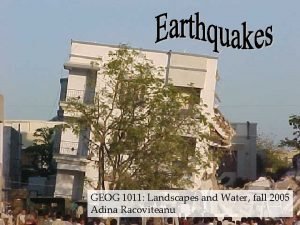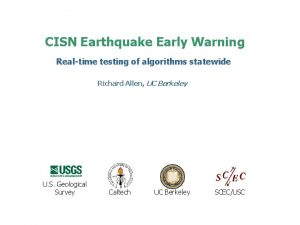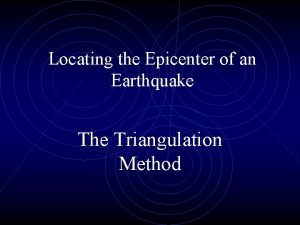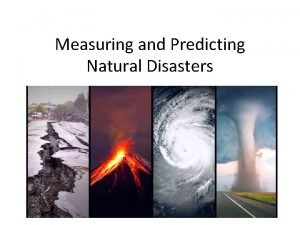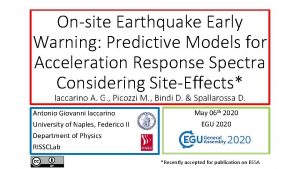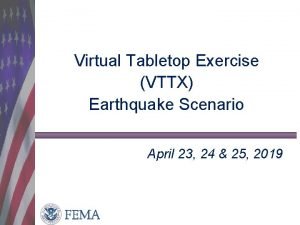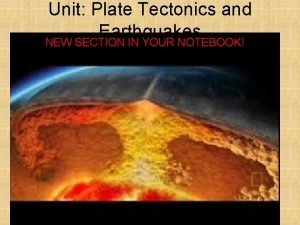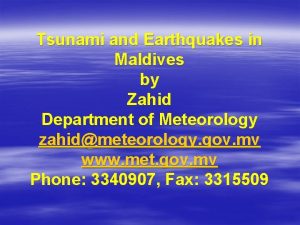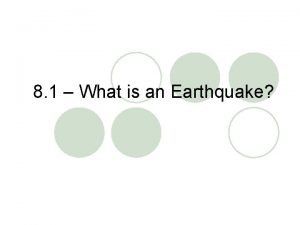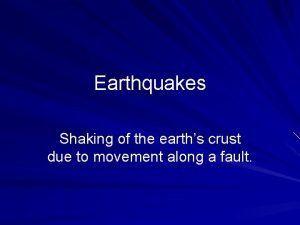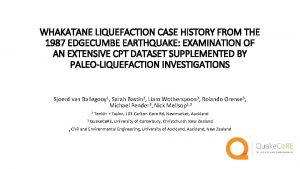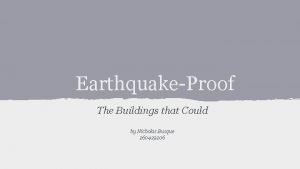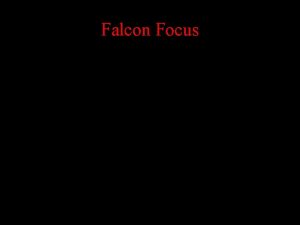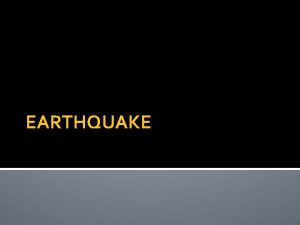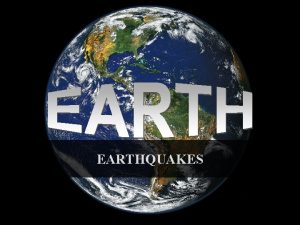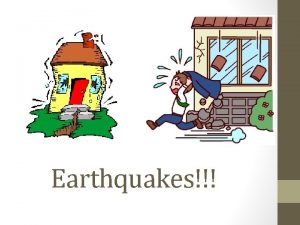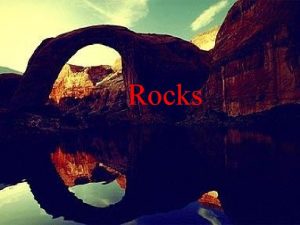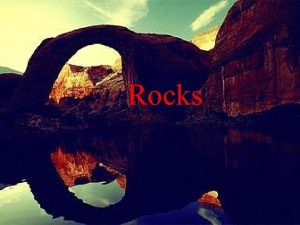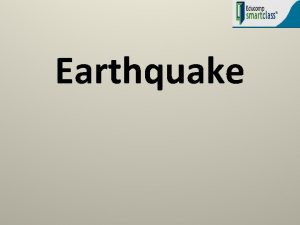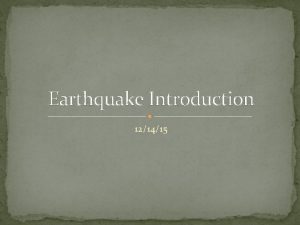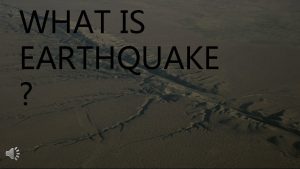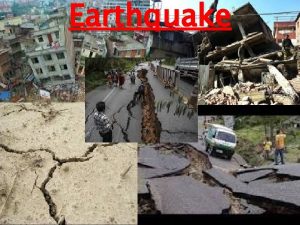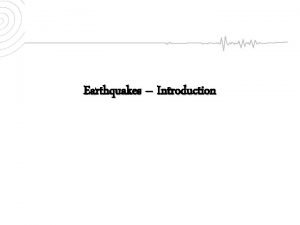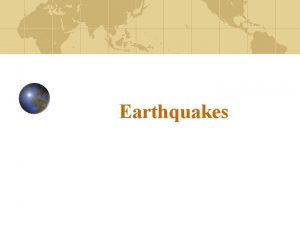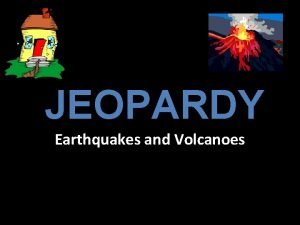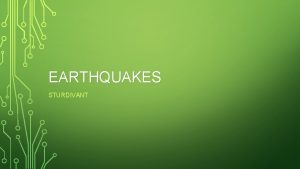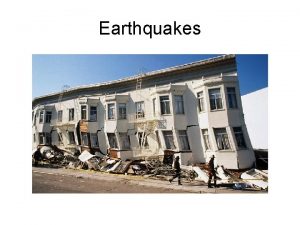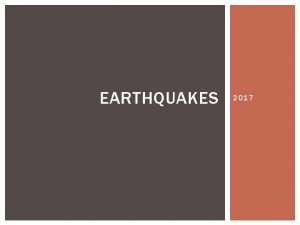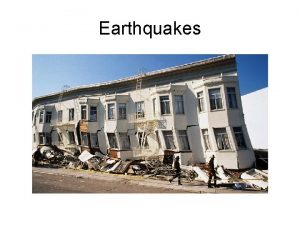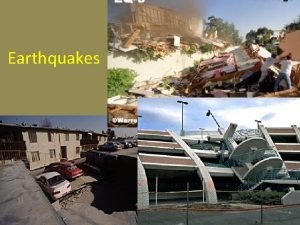13 Earthquakes Eric MartiAP Photo Earthquakes earthquake rocks





























































- Slides: 61

13 - Earthquakes Eric Marti/AP Photo

Earthquakes • earthquake: rocks breaking and movement of rock along break • fault: locus of the earthquake movement • faults come at all scales, mm to separation of lithospheric plates (e. g. , San Andreas).

Elastic Rebound Theory • Stress is applied to rock • Strain energy builds up for rock does not break at once • Eventually, rock ruptures and • Energy is released as heat & SEISMIC WAVES

Elastic Rebound Theory

Elastic Rebound Theory

Elastic Rebound Theory

Elastic Rebound Theory Fig. 18. 1 d

1906 San Francisco Earthquake G. K. Gilbert Fig. 18. 2

1906 San Francisco Earthquake Fault Offset (~2. 5 m) Fault Trace G. K. Gilbert Fig. 18. 2

Earthquake terms focus: site of initial rupture epicenter: point on surface above the focus

Seismic Waves Radiate from the Focus of an Earthquake

2 KINDS OF SEISMIC WAVES • BODY WAVES - WAVES THAT MOVE THROUGH THE BODY OF THE EARTH. • SURFACE WAVES - WAVES THAT MOVE ALONG THE SURFACE OF THE EARTH.

Two kinds of body waves • P waves (compressional) 6– 8 km/s. Parallel to direction of movement (slinky), also called primary waves. Similar to sound waves. • S waves (shear) 4– 5 km/s. Perpendicular to direction of movement (rope); also called secondary waves. Result from the shear strength of materials. Do not pass through liquids.

Seismic body waves

2 KINDS OF SURFACE WAVES • LOVE - rolling motion • RALEIGH - ground shakes sideways • These waves travel slower than swaves and are formed as p- and swave energy hits the surface.


Seismology • Study of the propagation of mechanical energy through the Earth; released by earthquakes and explosions. • When energy is released in this fashion, waves of motion (like the effect of a pebble tossed into a pond) are set up in the rocks surrounding the source of the energy (the focus).

Seismic waves • Waves are started because of initial tension or compression in the rock. • Instruments used to measure these waves are called seismographs.

The principle of the inertial seismograph

Recording earthquakes

Modern Seismograph Kinematics

Seismograph Record and Pathway of Three Types of Seismic Waves

Locating an epicenter • The difference between the arrival times of the P and S waves at a recording station is a function of the distance from the epicenter. • Therefore, you need three stations to determine the location of an epicenter - triangluation.

Locating an earthquake

Typical Seismograph record Average traveltime curves Fig. 16. 8

Seismic Travel-time Curve Fig. 18. 9 b

Locating the Epicenter

Global Positioning System (GPS) to Monitor Ground Motion Jet Propulsion Lab/NASA

Measuring the force of earthquakes 1. Surface displacement • 1964 Alaska earthquake displaced some parts of the seafloor by ~ 50 ft. • 1906 San Francisco earthquake moved the ground ~8. 5 ft. 2. Size of area displaced Alaska — 70, 000 sq. miles

Measuring the force of earthquakes 3. Duration of shaking Up to tens of seconds 4. Intensity scales (Modified Mercalli) Based on damage and human perception 5. Magnitude scales (Richter Scale) Based on amount of energy released

Modified Mercalli Intensity Scale I Not felt II Felt only by persons at rest III–IV Felt by persons indoors only V–VI Felt by all; some damage to plaster, chimneys VII People run outdoors, damage to poorly built structures VIII Well-built structures slightly damaged; poorly built structures suffer major damage IX Buildings shifted off foundations X Some well-built structures destroyed XI Few masonry structures remain standing; bridges destroyed XII Damage total; waves seen on ground; objects thrown into air

Richter Scale • Richter scale: amount of energy (ground shaking) received 100 km from epicenter • Largest quake ever recorded = 8. 9 (rocks not strong enough for more). • Earthquakes less than Mag. 2 are not felt by people. • Scale is logarithmic: Increase 1 unit = 10 times greater shaking Increase 1 unit = 30 times greater energy

Maximum Amplitude of Ground Shaking Determines Richter Magnitude

Richter Magnitude Versus Energy

6. Moment Magnitude Scale • New approach for indicates what happened at earthquake source rather than amount of ground shaking - based on amount of energy released – Product of : – Slip along fault – Area of fault break – Rock rigidity

Forcasting vs. Predicting Earthquakes • Forecast means to guess only at the place and magnitude of an earthquake • Predict means to guess at the place, magnitude and time of an event

Earthquake prediction Long term—imprecise (within 5 years) Short term—precise (very difficult) We can't stop earthquakes, so we have to be prepared for them.

SHORT TERM CLUES • • • Changes in speed of P-waves Change in tilt due to rx. dilation Unusual animal behavior Changes in water level in wells Foreshocks Seismic gaps - long term clue

Seismic Gaps in the circum-Pacific Belt

Stress Changes Caused by Regional Earthquakes in Southern California (1979 -1992)

Dilatancy of Highly Stressed Rocks

Damage due to earthquakes 1. DIRECT DAMAGE a. Ground movement “Earthquakes don’t kill people, buildings kill people. ” b. Ground Cracks 2. INDIRECT DAMAGE a. Fire b. Tidal waves (tsunami) generate speeds up to 500– 800 km/hr in open ocean; only ~ 1 m high but get larger when water gets shallow.

Damage due to earthquakes Indirect con’t c. All kinds of mass wasting Liquifaction – sudden loss of strength of water-saturated sediment Buildings sink intact d. Flood Dam break; rivers change course

Effects of the 1994 Northridge, CA, Earthquake 1994 Chronmo Sohn/Photo Researchers, Inc

Effects of the 1995 Kobe, Japan, Earthquake Fig. 18 Reuters/Corbis-Bettmann

Generation of a Tsunami Fig. 18. 19

Fig. 19. 18

Destruction Caused by 1998 Tsunami, Papua New Guinea Brian Cassey/AP Photo Fig. 18. 20

Tsunami Barrier in Taro, Japan Courtesy of Taro, Japan

New Housing Built Along the 1906 Trace of the San Andreas Fault R. E. Wallace, USGS Fig. 18. 22

Seismic Hazard Map Courtesy of Kaye M. Shedlock, USGS

Demonstrating Earthquake Safety in Japan Yves Gelie/Matriz

Recent Earthquakes of Special Interest Izmit Loma Prieta Kobe Northridge Papua

Distribution of earthquakes • Not random • Focused around plate margins in long linear belts • Also see in volcanic regions • And in plate interiors

World Seismicity, 1963– 2000

Earthquakes & Plate Margins • Divergent Margins - low magnitude & shallow focus (<100 km) earthquakes (eq) -> normal faulting • Transform Margins - shallow focus & intermediate magnitude -> strikeslip faulting

Earthquakes Associated with Divergent and Transform Margins

Earthquakes & Plate Margins con’t • Convergent subduction margins shallow to deep (700 km) & high magnitude eq. -> thrust & reversed faulting • Convergent collision margins - shallow to intermediate focus (300 km)& high magnitude eq. -> reversed & thrust faulting

Earthquakes Associated with Convergent Plate Margins

Benioff Zone beneath the Tonga Trench Fig. 16. 17

 Sedimentary rock song
Sedimentary rock song Igneous metamorphic and sedimentary
Igneous metamorphic and sedimentary Http://earthquake.usgs.gov/earthquakes/map/
Http://earthquake.usgs.gov/earthquakes/map/ Chronmo
Chronmo Rhyolite lame mince
Rhyolite lame mince Extrusive vs intrusive igneous rocks
Extrusive vs intrusive igneous rocks Chapter 8 earthquakes and earth's interior
Chapter 8 earthquakes and earth's interior Pearson education
Pearson education Normal fault definition
Normal fault definition Chapter 8 quiz 1
Chapter 8 quiz 1 Earthquake causes in points
Earthquake causes in points Positive effects of earthquakes
Positive effects of earthquakes Elastic rebound
Elastic rebound Chapter 19 earthquakes
Chapter 19 earthquakes In what section of earth do earthquakes happen?
In what section of earth do earthquakes happen? Richter magnitude scale
Richter magnitude scale Chapter 19 earthquakes
Chapter 19 earthquakes Chapter 8 earthquakes and earth's interior
Chapter 8 earthquakes and earth's interior Liquefaction occurs when seismic waves cause __________.
Liquefaction occurs when seismic waves cause __________. Chapter 8 earthquakes and volcanoes
Chapter 8 earthquakes and volcanoes Why do earthquakes occur
Why do earthquakes occur Frequent earthquakes in an area may indicate *
Frequent earthquakes in an area may indicate * Why some earthquakes cause more damage than others
Why some earthquakes cause more damage than others Seismograph
Seismograph Btn earthquakes
Btn earthquakes Earthquakes
Earthquakes A large crack in the earth formed by a river or earthquakes
A large crack in the earth formed by a river or earthquakes Two types of body waves
Two types of body waves Earthquakes
Earthquakes Diastrophism
Diastrophism Chapter 8 section 1 what are earthquakes
Chapter 8 section 1 what are earthquakes Landslides caused by earthquakes
Landslides caused by earthquakes Www tumblr.com search
Www tumblr.com search Epicenter of earthquake
Epicenter of earthquake Actual conduct of earthquake drill
Actual conduct of earthquake drill Mind map of tsunami
Mind map of tsunami Open cures
Open cures Earthquake map italy
Earthquake map italy Earthquake intensity depends primarily on the height of
Earthquake intensity depends primarily on the height of Earthquake p-wave and s-wave travel time graph
Earthquake p-wave and s-wave travel time graph Olive view hospital earthquake
Olive view hospital earthquake Earthquake slides
Earthquake slides Earthquake
Earthquake Earthquake foldable
Earthquake foldable Taiwan earthquake
Taiwan earthquake Earthquake
Earthquake Basilan and romblon tsunami
Basilan and romblon tsunami Ethz
Ethz Earthquake introduction
Earthquake introduction Cisn earthquake
Cisn earthquake Earthquake
Earthquake Triangulation earthquake
Triangulation earthquake Earthquake scale
Earthquake scale Earthquake early warning systems
Earthquake early warning systems Earthquake tabletop exercise
Earthquake tabletop exercise 1958 lituya bay earthquake and megatsunami
1958 lituya bay earthquake and megatsunami Earthquake maldives
Earthquake maldives Focus and epicenter of an earthquake
Focus and epicenter of an earthquake Earthquake occurs
Earthquake occurs Whakatane earthquake 1987
Whakatane earthquake 1987 Yokohama landmark tower earthquake proof
Yokohama landmark tower earthquake proof Earthquake parts diagram
Earthquake parts diagram


